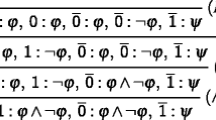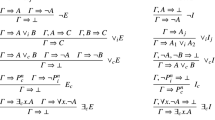Abstract
A new type of formalization of classical first-order logic with equality is introduced on the basis of the sequent calculus. It serves to justify the claim that equality is a logical constant characterised by well-behaved rules satisfying properties usually regarded as essential. The main feature of this approach is the application of sequents built not only from formulae but also from terms. Two variants of sequent calculus are examined, a structural and a logical one. The former is defined in accordance with Dos̆en’s criteria for logical constants. The latter is a standard Gentzen’s sequent calculus and satisfies Hacking’s criteria for logicality, including cut elimination. It is also shown that provided rules are harmonious in the sense advocated by Gratzl and Orlandelli.
Similar content being viewed by others
Notes
Strictly speaking in Reeves’ case it is n conclusions since he worked with tableux being upside-down versions of SC.
References
Avron, A., & Lev, I. (2001). Canonical propositional gentzen-type systems. In Proceedings of IJCAR’01. LNCS (Vol. 2083, pp. 529–543).
Carlström, J. (2005). Interpreting descriptions in intensional type theory. The Journal of Symbolic Logic, 70(2), 488–514.
Ciabattoni, A., Metcalfe, G., & Montagna, F. (2010). Algebraic and proof-theoretic characterizations of truth stressers for MTL and its extensions. Fuzzy Sets and Systems, 161(3), 369–389.
Dos̆en, K. (1985). Sequent-systems for modal logic. Journal of Symbolic Logic, 50, 149–159.
Dos̆en, K. (1989). Logical constants as punctuation marks. Notre Dame Journal of Formal Logic, 30, 362–381.
Fitting, M., & Mendelsohn, R. L. (1998). First-order modal logic. Dordrecht: Kluwer.
Francez, N. (2015). Proof-theoretic semantics. London: College Publications.
Frege, G. (1892). Über Sinn und Bedeutung. Zeitschrift für Philosophie und Philosophische Kritik, 100, 25–50.
Gallier, J. H. (1986). Logic for computer science. New York: Harper and Row.
Gazzari, R. (2021). The calculus of natural calculation. Studia Logica (to appear).
Goldblatt, R. (2011). Quantifiers, propositions and identity. Cambridge: Cambridge University Press.
Gratzl, N., & Orlandelli, E. (2017). Double-line harmony in sequent calculi. In P. Arazim & T. Lavicka (Eds.), The logica yearbook 2016 (pp. 157–171). Rickmansworth: College Publications.
Hacking, I. (1979). What is logic? The Journal of Philosophy, 76, 285–319.
Hintikka, J. (1956). Identity, variables and impredicative definitions. The Journal of Symbolic Logic, 21(3), 225–245.
Indrzejczak, A. (2015). Eliminability of cut in hypersequent calculi for some modal logics of linear frames. Information Processing Letters, 115(2), 75–81.
Indrzejczak, A. (2016). Simple cut elimination proof for hybrid logic. Logic and Logical Philosophy, 25(2), 129–141.
Indrzejczak, A. (2018). Cut-free modal theory of definite descriptions. In G. Bezhanishvili, et al. (Eds.), Advances in modal logic (Vol. 12, pp. 387–406). Rickmansworth: College Publications.
Indrzejczak, A. (2018). Rule-generation theorem and its applications. The Bulletin of the Section of Logic, 47(4), 265–281.
Indrzejczak, A. (2019). Fregean description theory in proof-theoretical setting. Logic and Logical Philosophy, 28(1), 137–155.
Indrzejczak, A. (2021). Logicality of equality. In P. Schroeder-Heister (Ed.), Proof-theoretic semantics. Outstanding contributions to logic. Berlin: Springer. (to appear).
Jaśkowski, S. (1934). On the rules of suppositions in formal logic. Studia Logica, 1, 5–32.
Kanger, S. (1957). Provability in logic. Stockholm: Almqvist & Wiksell.
Kurokawa, H. (2014). Hypersequent calculi for modal logics extending S4. In New frontiers in artificial intelligence (pp. 51–68). Springer.
Kürbis, N. (2019). Proof and falsity: A logical investigation. Cambridge: Cambridge University Press.
Manzano, M. (1999). Model theory. Oxford: Oxford University Press.
Manzano, M. (2005). Extensions of first-order logic. Cambridge: Cambridge University Press.
Manzano, M., & Moreno, M. C. (2017). Identity, equality, nameability and completeness. The Bulletin of the Section of Logic, 46(3–4), 169–196.
Maruyama, Y. (2016). Categorical harmony and paradoxes in proof-theoretic semantics. In T. Piecha & P. Schroeder-Heister (Eds.), Advances in proof-theoretic semantics (pp. 95–114). Berlin: Springer.
Metcalfe, G., Olivetti, N., & Gabbay, D. (2008). Proof theory for fuzzy logics. Berlin: Springer.
Nagashima, T. (1966). An extension of the Craig-Schütte interpolation theorem. Annals of the Japan Association for the Philosophy of Science, 3, 12–18.
Negri, S., & von Plato, J. (2001). Structural proof theory. Cambridge: Cambridge University Press.
Parlamento, F., & Previale, F. (2019). The elimination of atomic cuts and the semishortening property for Gentzen’s sequent calculus with equality. The Review of Symbolic Logic,. https://doi.org/10.1017/S175502031900039X. (on-line first).
Poggiolesi, F. (2011). Gentzen calculi for modal propositional logic. Berlin: Springer.
Priest, G. (2010). Non-transitive identity. In R. Dietz & S. Moruzzi (Eds.), Cuts and clouds: Vagueness, its nature and its logic (pp. 406–416). Oxford: Oxford University Press.
Quine, W. V. (1970). Philosophy of logic. Upper Saddle River: Prentice Hall.
Read, S. (2004). Identity and harmony. Analysis, 64(2), 113–119.
Reeves, S. V. (1987). Adding equality to semantic tableau. Journal of Automated Reasoning, 3, 225–246.
Restall, G. (2019a). Generality and existence 1: Quantification and free logic. The Review of Symbolic Logic, 12(1), 354–378.
Restall, G. (2019b). Assertions, denials, questions, answers and the common ground. Retrieved from http://consequently.org/writing. Accessed 20 Oct 2019.
Sambin, G., Battilotti, G., & Faggian, C. (2000). Basic logic: Reflection, symmetry, visibility. Journal of Symbolic Logic, 65, 979–1013.
Schroeder-Heister, P. (2012). Proof-theoretic semantics. In Stanford encyclopedia of philosophy. Retrieved from https://plato.stanford.edu/entries/proof-theoretic-semantics/. Accessed 12 Nov 2018.
Schroeder-Heister, P. (2016). Open problems in proof-theoretic semantics. In T. Piecha & P. Schroeder-Heister (Eds.), Advances in proof-theoretic semantics (pp. 253–283). Berlin: Springer.
Stenlund, S. (1973). The logic of description and existence. Filosofiska Studier no 18, Uppsala.
Stenlund, S. (1975). Descriptions in intuitionistic logic. In S. Kanger (Ed.), Proceedings of the third Scandinavian logic symposium (pp. 197–212).
Tennant, N. (2010). Harmony in a sequent setting. Analysis, 70, 462–468.
Textor, M. (2017). Towards a Neo-Brentanian theory of existence. Philosophers’ Imprint, 17(6), 1–20.
Troelstra, A. S., & van Dalen, D. (1988). Constructivism in mathematics. Amsterdam: North-Holland.
Troelstra, A. S., & Schwichtenberg, H. (1996). Basic proof theory. Oxford: Oxford University Press.
Wansing, H. (1999). Displaying modal logics. Dordrecht: Kluwer Academic Publishers.
Wansing, H., & Skurt, D. (2019). On non-transitive “identity”. In C. Baskent & T. M. Fergusson (Eds.), Graham priest on dialetheism and paraconsistency. Outstanding contributions to logic (Vol. 18, pp. 535–553). Berlin: Springer.
Wehmeier, K. (2014). How to live without identity- and why. Australasian Journal of Philosophy, 90, 761–777.
Wittgenstein, L. (1922). Tractatus logico-philosophicus. New York: Harcourt Brace and Co.
Acknowledgements
I am greatly indebted to Nils Kürbis, René Gazzari, and to all reviewers for insightful remarks which helped to improve the final version of this text. The results reported in this paper are supported by the National Science Centre, Poland (Grant Number: DEC-2017/25/B/HS1/01268).
Author information
Authors and Affiliations
Corresponding author
Additional information
Publisher's Note
Springer Nature remains neutral with regard to jurisdictional claims in published maps and institutional affiliations.
Rights and permissions
About this article
Cite this article
Indrzejczak, A. A novel approach to equality. Synthese 199, 4749–4774 (2021). https://doi.org/10.1007/s11229-020-03000-8
Received:
Accepted:
Published:
Issue Date:
DOI: https://doi.org/10.1007/s11229-020-03000-8




